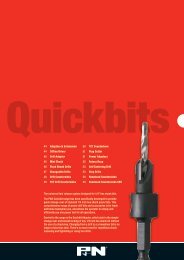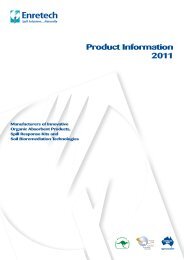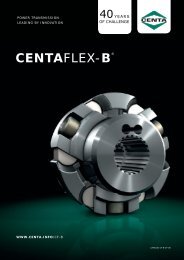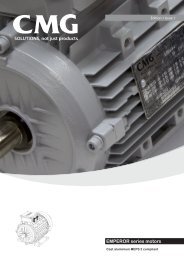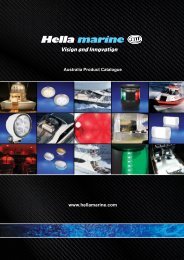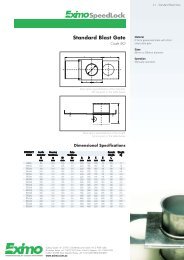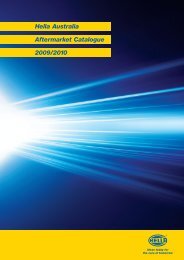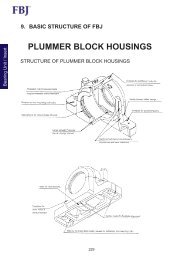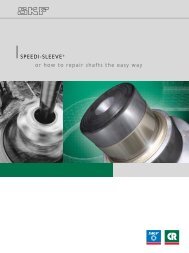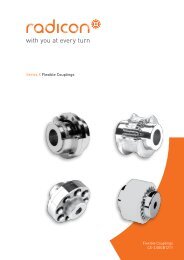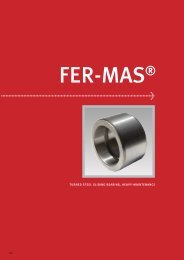download Product Catalogue PDF (2.4MB) - Goliath Threading Tools
download Product Catalogue PDF (2.4MB) - Goliath Threading Tools
download Product Catalogue PDF (2.4MB) - Goliath Threading Tools
Create successful ePaper yourself
Turn your PDF publications into a flip-book with our unique Google optimized e-Paper software.
TECHNICAL INFORMATION<br />
Thread Systems<br />
The ISO Standard is the International Standard intended to be adopted throughout the World. The ISO standard covers<br />
three groups of threads:-<br />
• ISO – Metric which is a complete thread system in Metric Units<br />
• ISO – UniÞ ed screw thread systems<br />
• ISO – British Standard Pipe thread systems<br />
The Whitworth and BA screw thread systems are ofÞ cially obsolete. However, they are still widely used throughout the<br />
world and GOLIATH offer a full range of Taps and Dies within these standards.<br />
All measurements must have a controlling point or base from which to star. In case of a screw thread, this control point<br />
is called the BASIC or theoretically correct size, which is calculated on the basis of a full form thread. Thus, on a given<br />
screw thread, we have Basic Major Diameter, the Basic Pitch Diameter and Basic Minor Diameter.<br />
The Basic ProÞ le is the proÞ le to which the deviations, which deÞ ne the limits of the external and internal threads, are<br />
applied. While it is impossible in practice to form screw threads to their precise theoretical or BASIC sizes, it is possible<br />
and practical to establish limits which the deviation must not exceed. These are called the “Maximum” and “Minimum”<br />
Limits. If the product is no smaller than the “Minimum Limit” and no larger than the “Maximum Limit”, then it is within the<br />
size limits required. This difference between the Maximum and Minimum Limit is the TOLERANCE.<br />
In actual practice the Basic size is not necessarily between Maximum and Minimum Limits. In most cases, the Basic Size<br />
is one of the Limits. In general, tolerances for internal threads will be above Basic and for external threads, below Basic.<br />
Tolerance Classes of Metric Taps<br />
Three tolerance classes (termed Class 1, Class2 and Class 3) are used for the designation of the taps for the production<br />
of nuts of the following classes:<br />
• 4H, 5H, 6H, 7H, 8H with zero minimum clearance<br />
• 4G, 5G, 6G with positive minimum clearance<br />
The tolerances for these three classes are determined in BS 949, in terms of tolerance unit t.<br />
The Difference in the Classes<br />
Taps of the different classes vary in the limits of the size of the tap pitch diameter. The tolerance on the tap pitch diameter<br />
Td2 is the same for all three classes of tap (it is equal to 20% of t), but the position of the tolerance zone with respect to<br />
the basic pitch diameter depends on the lower deviation.<br />
• Lower Deviation for tap Class 1, + 0.1 t<br />
• Lower Deviation for tap Class 2, + 0.3 t<br />
• Lower Deviation for tap Class 3, + 0.5 t<br />
Choice of Tap Tolerance Class<br />
Unless other wise speciÞ ed, taps of classes 1, 2 and 3 are used for<br />
the manufacture of nuts in the following classes:<br />
• Class 1: for nuts of classes 4H and 5H<br />
• Class 2: for nuts of classes 6H and also 4G and 5G<br />
• Class 3: for nuts of classes 7H and 8H and also 6G<br />
However, this correspondence is only of a general nature, since<br />
the accuracy of tapping varies with a number of factors such as the<br />
material being tapped, the condition of the machine tool, the tapping<br />
attachment, the tapping speed and the lubricant used.<br />
Users are therefore recommended to select in each case, from previous experience or from special purpose tests, the<br />
most suitable class of tap for the manufacture of any required class of nut.<br />
www.goliathinternational.com<br />
51



